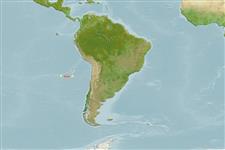Environment: milieu / climate zone / depth range / distribution range
Écologie
marin benthopélagique; profondeur 180 - 400 m (Ref. 6181). Deep-water; 20°S - 27°S, 90°W - 81°W (Ref. 6181)
Southeast Pacific: known only from seamounts of Nazca Submarine Ridge and adjacent parts of Sala y Gomez Ridge.
Taille / Poids / Âge
Maturity: Lm ? range ? - ? cm
Max length : 43.0 cm SL mâle / non sexé; (Ref. 6181); âge max. reporté: 15 années (Ref. 6204)
Épines dorsales (Total): 18; Rayons mous dorsaux (Total): 15-18; Épines anales 2; Rayons mous anaux: 12 - 14; Vertèbres: 34. Lateral line branching below the 5th to 7th spine of the first dorsal fin, usually ending below the third to the last spine of the first dorsal fin. The lower branch runs mid laterally, sometimes undulating on caudal peduncle. Body is entirely scaled at a length of over 20 cm SL. Pyloric caeca 7 or 8. Body color is brown with silvery tint; anterior 2 membranes of the first dorsal fin black, the rest of the fin black edged; the posterior part of the pectoral fin is black.
Feeds on squid and fish. Matures at about 25 cm.
Life cycle and mating behavior
Maturité | Reproduction | Frai | Œufs | Fécondité | Larves
Nakamura, I. and N.V. Parin, 1993. FAO Species Catalogue. Vol. 15. Snake mackerels and cutlassfishes of the world (families Gempylidae and Trichiuridae). An annotated and illustrated catalogue of the snake mackerels, snoeks, escolars, gemfishes, sackfishes, domine, oilfish, cutlassfishes,. scabbardfishes, hairtails, and frostfishes known to date. FAO Fish. Synop. 125(15):136 p. (Ref. 6181)
Statut dans la liste rouge de l'IUCN (Ref. 130435)
Menace pour l'homme
Harmless
Utilisations par l'homme
Plus d'informations
Noms communsSynonymesMétabolismePrédateursÉcotoxicologieReproductionMaturitéFraiRassemblement de ponteFéconditéŒufsDéveloppement de l'œuf
RéférencesAquacultureProfil d'aquacultureSouchesGénétiqueElectrophoresesHéritabilitéPathologiesTraitementNutrientsMass conversion
CollaborateursImagesStamps, Coins Misc.SonsCiguateraVitesseType de nageSurface branchialeOtolithesCerveauxVision
Outils
Articles particuliers
Télécharger en XML
Sources Internet
Estimates based on models
Preferred temperature (Ref.
123201): 10.6 - 11.1, mean 10.8 °C (based on 10 cells).
Phylogenetic diversity index (Ref.
82804): PD
50 = 0.5078 [Uniqueness, from 0.5 = low to 2.0 = high].
Bayesian length-weight: a=0.00363 (0.00163 - 0.00807), b=3.10 (2.91 - 3.29), in cm total length, based on LWR estimates for this (Sub)family-body shape (Ref.
93245).
Niveau trophique (Ref.
69278): 4.5 ±0.62 se; based on food items.
Résilience (Ref.
120179): Faible, temps minimum de doublement de population : 4,5 à 14 années (tmax=15).
Fishing Vulnerability (Ref.
59153): Moderate vulnerability (41 of 100).
